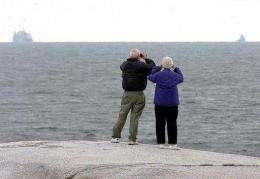Water levels down in Canada's Saint Lawrence seaway

Seasonal water levels in the Saint Lawrence seaway -- a major North American shipping corridor -- have reached their lowest point in 40 years, the Quebec hydro center warned Friday.
This follows one of the warmest Canadian winters on record, in which very little snow fell.
Hydrometric meters showed an average of 7,000 cubic meters per second (247,200 cubic feet per second) flowing past the island city of Montreal, much lower than the norm of 10,000 cubic meters per second (353,100 cubic feet per second) for this time of year.
Environment Canada said fish are likely to suffer the most. Pike, for example, spawn their eggs in flooded plains along the banks of the seaway that remained unusually dry this year.
Barges and ocean-going vessels that travel along the system of locks, canals and channels from the Atlantic Ocean to the North American Great Lakes, have also had to reduce loads.
Alfred Jaouich, a researcher at the University of Quebec in Montreal (UQAM) blamed "a winter with little precipitation in the region of the Great Lakes," which hold 25 percent of the world's fresh water reserves, and other tributaries.
The Great Lakes themselves are also at record low water levels, officials said.
(c) 2010 AFP














